GEOG 101: Maquilapolis Case Study - Environmental and Social Impacts
VerifiedAdded on 2022/07/27
|6
|1801
|37
Homework Assignment
AI Summary
This assignment analyzes the documentary film 'Maquilapolis,' focusing on the environmental and social consequences of industrialization in the US-Mexico border region. The paper examines the concept of despotism, specifically racialized and sexualized forms, as experienced by female workers in the maquiladoras (factories). It highlights the exploitative labor conditions, including low wages, lack of worker protections, and health hazards stemming from exposure to toxic materials. The analysis further critiques the claim that economic growth leads to environmental improvement, arguing that the maquiladoras have caused severe pollution and degradation of the environment, including air, water, and land contamination. The assignment discusses the role of NAFTA and the Mexican government's policies in facilitating the growth of these factories and the lack of corporate responsibility. The paper references several scholarly articles and reports to support its arguments, concluding that the economic development has turned into a 'curse' for the residents of the region, leading to health problems and environmental damage.
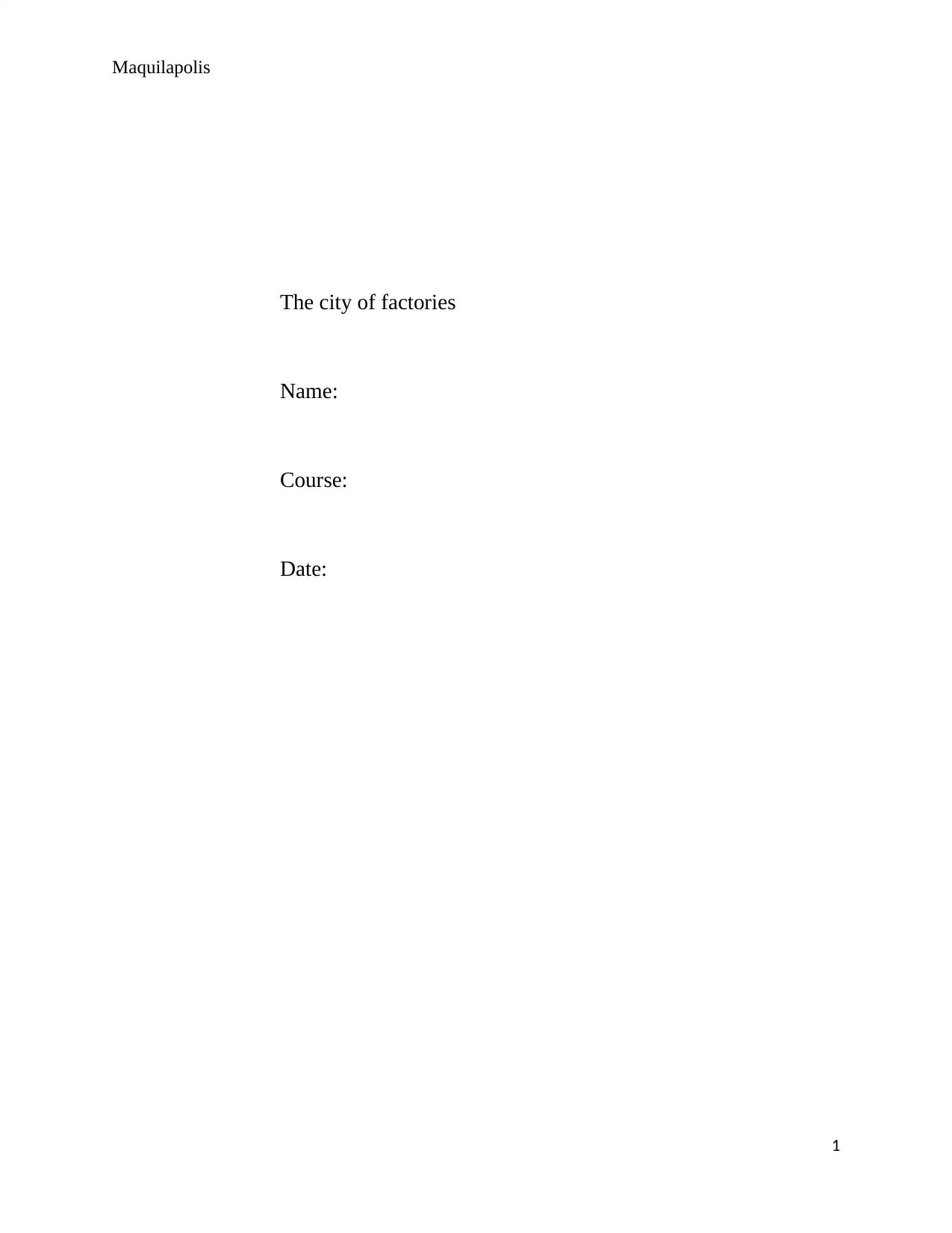
Maquilapolis
The city of factories
Name:
Course:
Date:
1
The city of factories
Name:
Course:
Date:
1
Paraphrase This Document
Need a fresh take? Get an instant paraphrase of this document with our AI Paraphraser
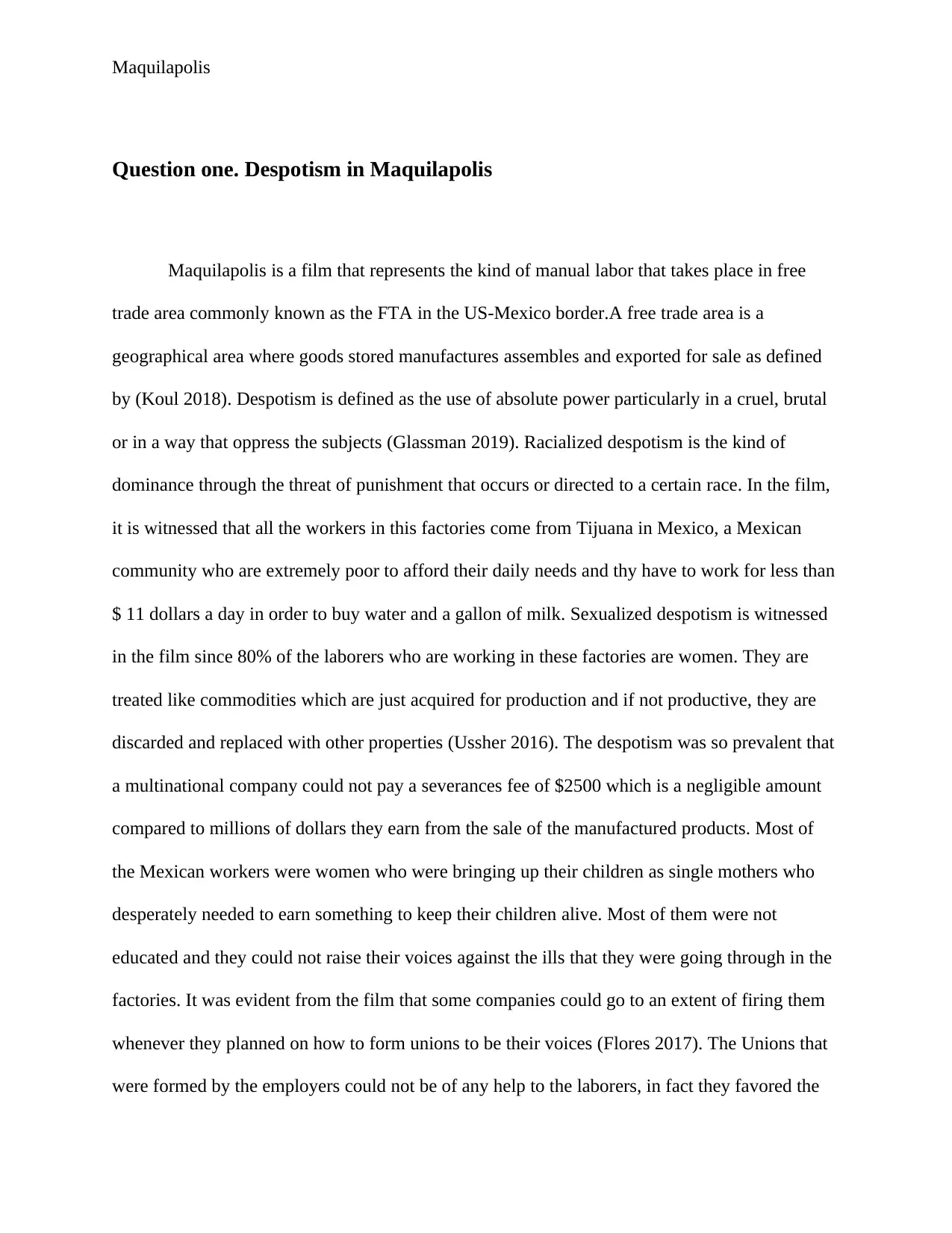
Maquilapolis
Question one. Despotism in Maquilapolis
Maquilapolis is a film that represents the kind of manual labor that takes place in free
trade area commonly known as the FTA in the US-Mexico border.A free trade area is a
geographical area where goods stored manufactures assembles and exported for sale as defined
by (Koul 2018). Despotism is defined as the use of absolute power particularly in a cruel, brutal
or in a way that oppress the subjects (Glassman 2019). Racialized despotism is the kind of
dominance through the threat of punishment that occurs or directed to a certain race. In the film,
it is witnessed that all the workers in this factories come from Tijuana in Mexico, a Mexican
community who are extremely poor to afford their daily needs and thy have to work for less than
$ 11 dollars a day in order to buy water and a gallon of milk. Sexualized despotism is witnessed
in the film since 80% of the laborers who are working in these factories are women. They are
treated like commodities which are just acquired for production and if not productive, they are
discarded and replaced with other properties (Ussher 2016). The despotism was so prevalent that
a multinational company could not pay a severances fee of $2500 which is a negligible amount
compared to millions of dollars they earn from the sale of the manufactured products. Most of
the Mexican workers were women who were bringing up their children as single mothers who
desperately needed to earn something to keep their children alive. Most of them were not
educated and they could not raise their voices against the ills that they were going through in the
factories. It was evident from the film that some companies could go to an extent of firing them
whenever they planned on how to form unions to be their voices (Flores 2017). The Unions that
were formed by the employers could not be of any help to the laborers, in fact they favored the
Question one. Despotism in Maquilapolis
Maquilapolis is a film that represents the kind of manual labor that takes place in free
trade area commonly known as the FTA in the US-Mexico border.A free trade area is a
geographical area where goods stored manufactures assembles and exported for sale as defined
by (Koul 2018). Despotism is defined as the use of absolute power particularly in a cruel, brutal
or in a way that oppress the subjects (Glassman 2019). Racialized despotism is the kind of
dominance through the threat of punishment that occurs or directed to a certain race. In the film,
it is witnessed that all the workers in this factories come from Tijuana in Mexico, a Mexican
community who are extremely poor to afford their daily needs and thy have to work for less than
$ 11 dollars a day in order to buy water and a gallon of milk. Sexualized despotism is witnessed
in the film since 80% of the laborers who are working in these factories are women. They are
treated like commodities which are just acquired for production and if not productive, they are
discarded and replaced with other properties (Ussher 2016). The despotism was so prevalent that
a multinational company could not pay a severances fee of $2500 which is a negligible amount
compared to millions of dollars they earn from the sale of the manufactured products. Most of
the Mexican workers were women who were bringing up their children as single mothers who
desperately needed to earn something to keep their children alive. Most of them were not
educated and they could not raise their voices against the ills that they were going through in the
factories. It was evident from the film that some companies could go to an extent of firing them
whenever they planned on how to form unions to be their voices (Flores 2017). The Unions that
were formed by the employers could not be of any help to the laborers, in fact they favored the
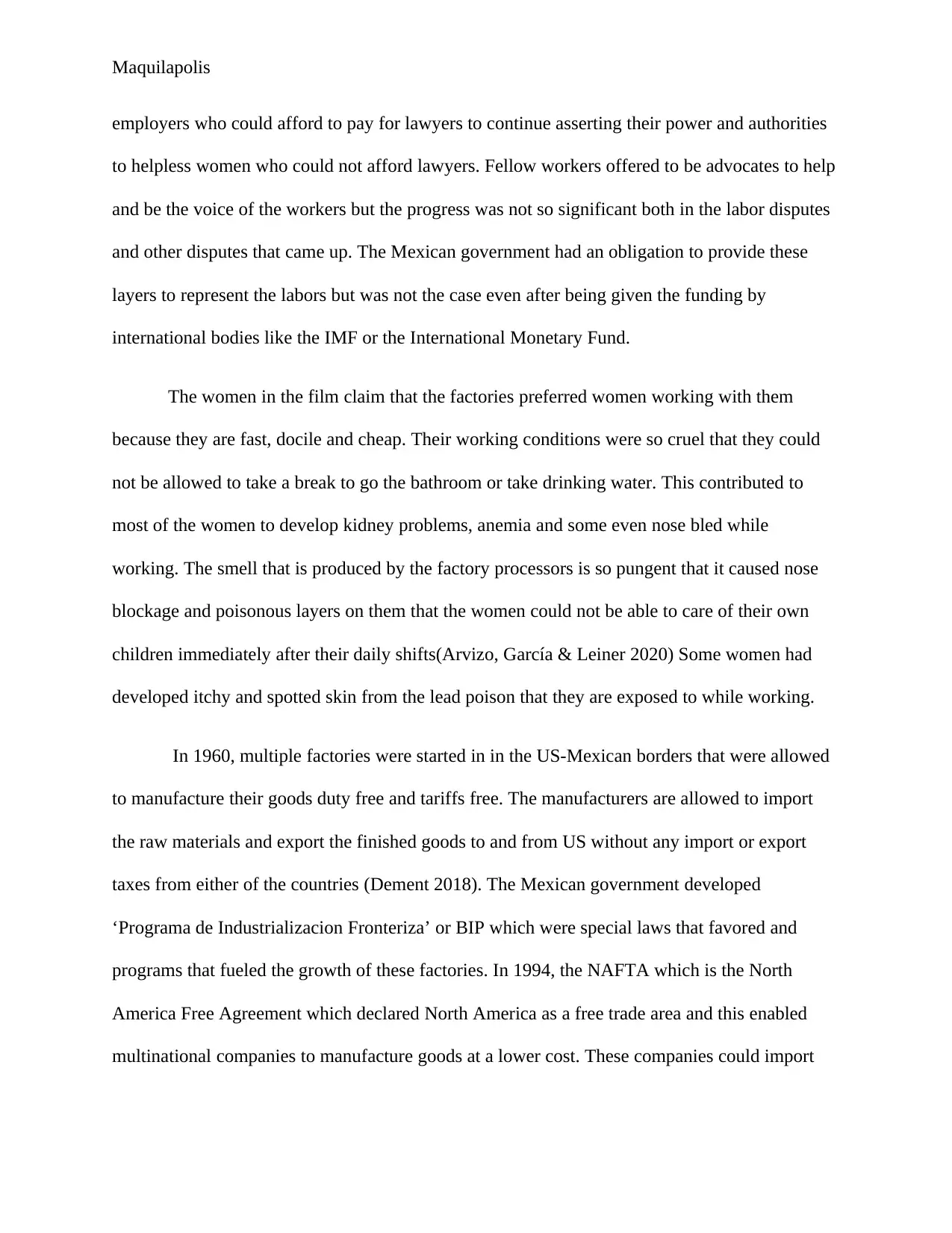
Maquilapolis
employers who could afford to pay for lawyers to continue asserting their power and authorities
to helpless women who could not afford lawyers. Fellow workers offered to be advocates to help
and be the voice of the workers but the progress was not so significant both in the labor disputes
and other disputes that came up. The Mexican government had an obligation to provide these
layers to represent the labors but was not the case even after being given the funding by
international bodies like the IMF or the International Monetary Fund.
The women in the film claim that the factories preferred women working with them
because they are fast, docile and cheap. Their working conditions were so cruel that they could
not be allowed to take a break to go the bathroom or take drinking water. This contributed to
most of the women to develop kidney problems, anemia and some even nose bled while
working. The smell that is produced by the factory processors is so pungent that it caused nose
blockage and poisonous layers on them that the women could not be able to care of their own
children immediately after their daily shifts(Arvizo, García & Leiner 2020) Some women had
developed itchy and spotted skin from the lead poison that they are exposed to while working.
In 1960, multiple factories were started in in the US-Mexican borders that were allowed
to manufacture their goods duty free and tariffs free. The manufacturers are allowed to import
the raw materials and export the finished goods to and from US without any import or export
taxes from either of the countries (Dement 2018). The Mexican government developed
‘Programa de Industrializacion Fronteriza’ or BIP which were special laws that favored and
programs that fueled the growth of these factories. In 1994, the NAFTA which is the North
America Free Agreement which declared North America as a free trade area and this enabled
multinational companies to manufacture goods at a lower cost. These companies could import
employers who could afford to pay for lawyers to continue asserting their power and authorities
to helpless women who could not afford lawyers. Fellow workers offered to be advocates to help
and be the voice of the workers but the progress was not so significant both in the labor disputes
and other disputes that came up. The Mexican government had an obligation to provide these
layers to represent the labors but was not the case even after being given the funding by
international bodies like the IMF or the International Monetary Fund.
The women in the film claim that the factories preferred women working with them
because they are fast, docile and cheap. Their working conditions were so cruel that they could
not be allowed to take a break to go the bathroom or take drinking water. This contributed to
most of the women to develop kidney problems, anemia and some even nose bled while
working. The smell that is produced by the factory processors is so pungent that it caused nose
blockage and poisonous layers on them that the women could not be able to care of their own
children immediately after their daily shifts(Arvizo, García & Leiner 2020) Some women had
developed itchy and spotted skin from the lead poison that they are exposed to while working.
In 1960, multiple factories were started in in the US-Mexican borders that were allowed
to manufacture their goods duty free and tariffs free. The manufacturers are allowed to import
the raw materials and export the finished goods to and from US without any import or export
taxes from either of the countries (Dement 2018). The Mexican government developed
‘Programa de Industrializacion Fronteriza’ or BIP which were special laws that favored and
programs that fueled the growth of these factories. In 1994, the NAFTA which is the North
America Free Agreement which declared North America as a free trade area and this enabled
multinational companies to manufacture goods at a lower cost. These companies could import
⊘ This is a preview!⊘
Do you want full access?
Subscribe today to unlock all pages.

Trusted by 1+ million students worldwide
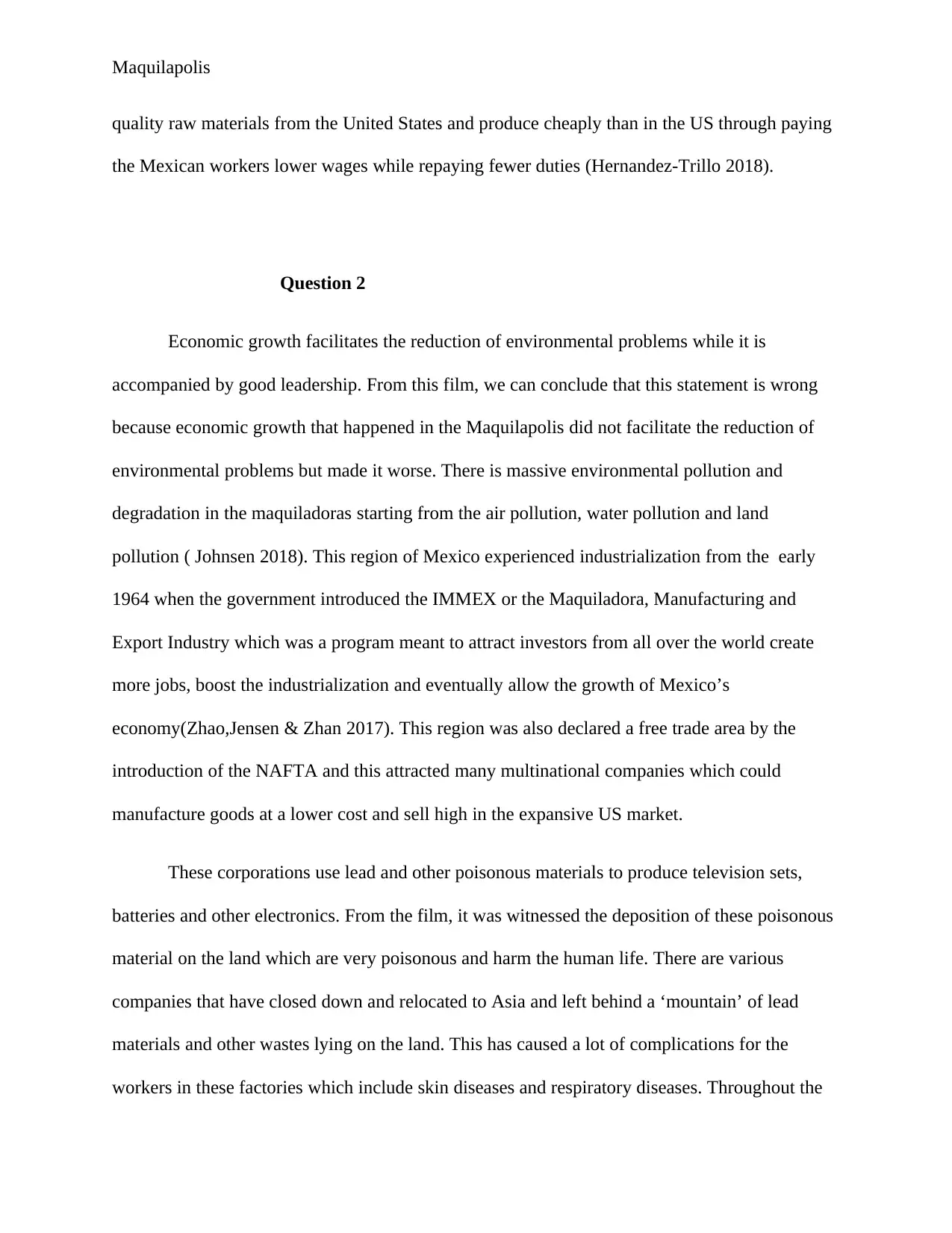
Maquilapolis
quality raw materials from the United States and produce cheaply than in the US through paying
the Mexican workers lower wages while repaying fewer duties (Hernandez-Trillo 2018).
Question 2
Economic growth facilitates the reduction of environmental problems while it is
accompanied by good leadership. From this film, we can conclude that this statement is wrong
because economic growth that happened in the Maquilapolis did not facilitate the reduction of
environmental problems but made it worse. There is massive environmental pollution and
degradation in the maquiladoras starting from the air pollution, water pollution and land
pollution ( Johnsen 2018). This region of Mexico experienced industrialization from the early
1964 when the government introduced the IMMEX or the Maquiladora, Manufacturing and
Export Industry which was a program meant to attract investors from all over the world create
more jobs, boost the industrialization and eventually allow the growth of Mexico’s
economy(Zhao,Jensen & Zhan 2017). This region was also declared a free trade area by the
introduction of the NAFTA and this attracted many multinational companies which could
manufacture goods at a lower cost and sell high in the expansive US market.
These corporations use lead and other poisonous materials to produce television sets,
batteries and other electronics. From the film, it was witnessed the deposition of these poisonous
material on the land which are very poisonous and harm the human life. There are various
companies that have closed down and relocated to Asia and left behind a ‘mountain’ of lead
materials and other wastes lying on the land. This has caused a lot of complications for the
workers in these factories which include skin diseases and respiratory diseases. Throughout the
quality raw materials from the United States and produce cheaply than in the US through paying
the Mexican workers lower wages while repaying fewer duties (Hernandez-Trillo 2018).
Question 2
Economic growth facilitates the reduction of environmental problems while it is
accompanied by good leadership. From this film, we can conclude that this statement is wrong
because economic growth that happened in the Maquilapolis did not facilitate the reduction of
environmental problems but made it worse. There is massive environmental pollution and
degradation in the maquiladoras starting from the air pollution, water pollution and land
pollution ( Johnsen 2018). This region of Mexico experienced industrialization from the early
1964 when the government introduced the IMMEX or the Maquiladora, Manufacturing and
Export Industry which was a program meant to attract investors from all over the world create
more jobs, boost the industrialization and eventually allow the growth of Mexico’s
economy(Zhao,Jensen & Zhan 2017). This region was also declared a free trade area by the
introduction of the NAFTA and this attracted many multinational companies which could
manufacture goods at a lower cost and sell high in the expansive US market.
These corporations use lead and other poisonous materials to produce television sets,
batteries and other electronics. From the film, it was witnessed the deposition of these poisonous
material on the land which are very poisonous and harm the human life. There are various
companies that have closed down and relocated to Asia and left behind a ‘mountain’ of lead
materials and other wastes lying on the land. This has caused a lot of complications for the
workers in these factories which include skin diseases and respiratory diseases. Throughout the
Paraphrase This Document
Need a fresh take? Get an instant paraphrase of this document with our AI Paraphraser
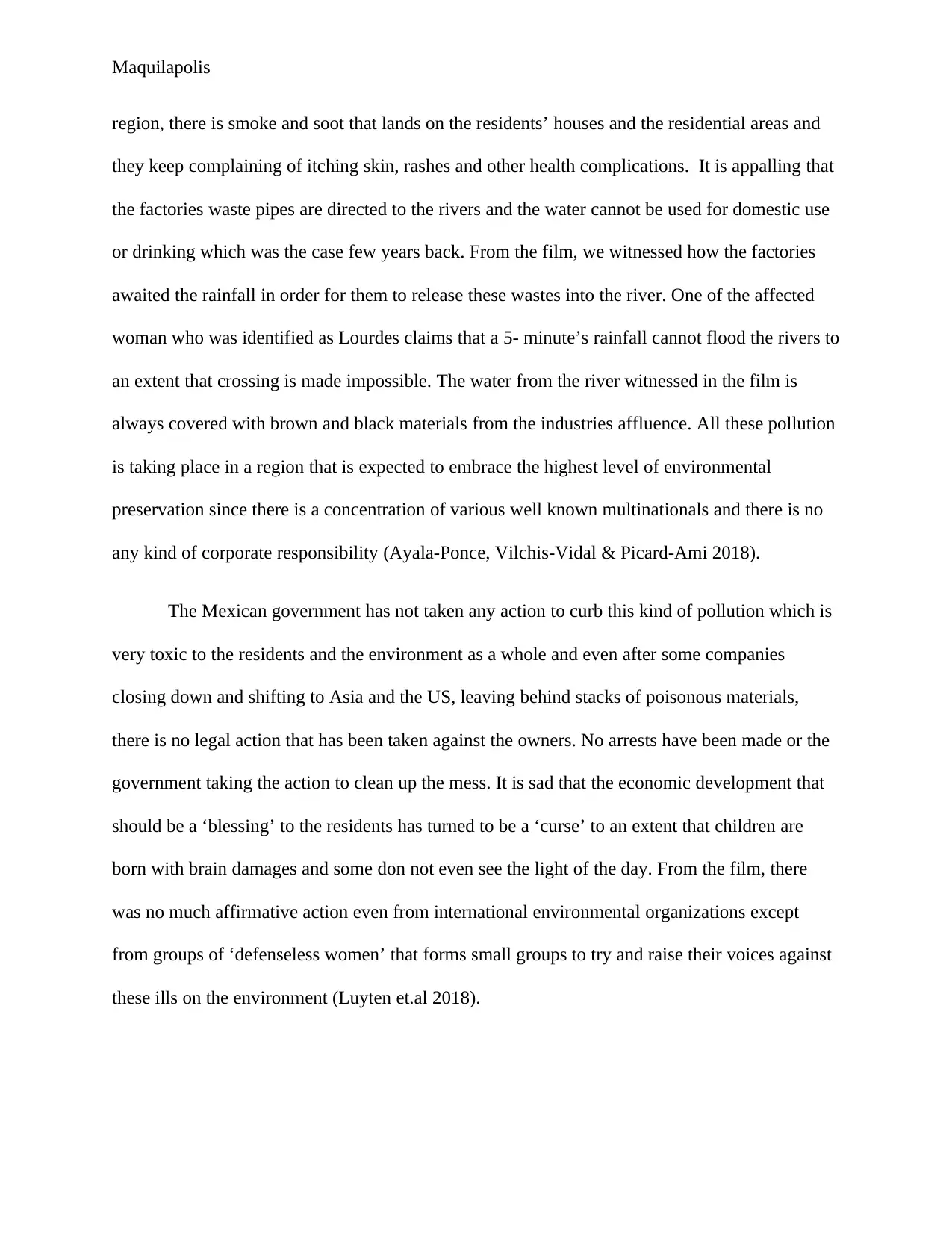
Maquilapolis
region, there is smoke and soot that lands on the residents’ houses and the residential areas and
they keep complaining of itching skin, rashes and other health complications. It is appalling that
the factories waste pipes are directed to the rivers and the water cannot be used for domestic use
or drinking which was the case few years back. From the film, we witnessed how the factories
awaited the rainfall in order for them to release these wastes into the river. One of the affected
woman who was identified as Lourdes claims that a 5- minute’s rainfall cannot flood the rivers to
an extent that crossing is made impossible. The water from the river witnessed in the film is
always covered with brown and black materials from the industries affluence. All these pollution
is taking place in a region that is expected to embrace the highest level of environmental
preservation since there is a concentration of various well known multinationals and there is no
any kind of corporate responsibility (Ayala‐Ponce, Vilchis‐Vidal & Picard‐Ami 2018).
The Mexican government has not taken any action to curb this kind of pollution which is
very toxic to the residents and the environment as a whole and even after some companies
closing down and shifting to Asia and the US, leaving behind stacks of poisonous materials,
there is no legal action that has been taken against the owners. No arrests have been made or the
government taking the action to clean up the mess. It is sad that the economic development that
should be a ‘blessing’ to the residents has turned to be a ‘curse’ to an extent that children are
born with brain damages and some don not even see the light of the day. From the film, there
was no much affirmative action even from international environmental organizations except
from groups of ‘defenseless women’ that forms small groups to try and raise their voices against
these ills on the environment (Luyten et.al 2018).
region, there is smoke and soot that lands on the residents’ houses and the residential areas and
they keep complaining of itching skin, rashes and other health complications. It is appalling that
the factories waste pipes are directed to the rivers and the water cannot be used for domestic use
or drinking which was the case few years back. From the film, we witnessed how the factories
awaited the rainfall in order for them to release these wastes into the river. One of the affected
woman who was identified as Lourdes claims that a 5- minute’s rainfall cannot flood the rivers to
an extent that crossing is made impossible. The water from the river witnessed in the film is
always covered with brown and black materials from the industries affluence. All these pollution
is taking place in a region that is expected to embrace the highest level of environmental
preservation since there is a concentration of various well known multinationals and there is no
any kind of corporate responsibility (Ayala‐Ponce, Vilchis‐Vidal & Picard‐Ami 2018).
The Mexican government has not taken any action to curb this kind of pollution which is
very toxic to the residents and the environment as a whole and even after some companies
closing down and shifting to Asia and the US, leaving behind stacks of poisonous materials,
there is no legal action that has been taken against the owners. No arrests have been made or the
government taking the action to clean up the mess. It is sad that the economic development that
should be a ‘blessing’ to the residents has turned to be a ‘curse’ to an extent that children are
born with brain damages and some don not even see the light of the day. From the film, there
was no much affirmative action even from international environmental organizations except
from groups of ‘defenseless women’ that forms small groups to try and raise their voices against
these ills on the environment (Luyten et.al 2018).
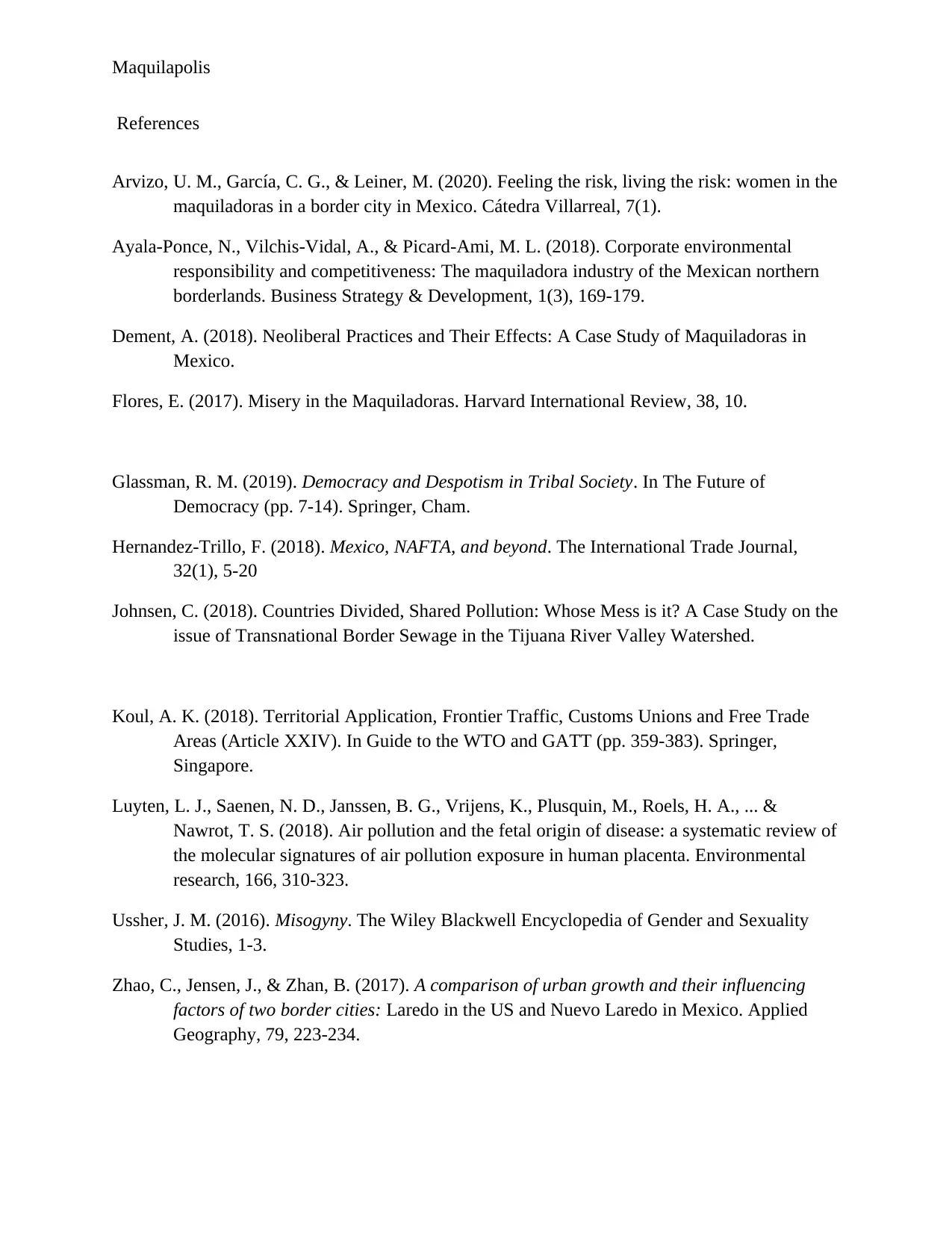
Maquilapolis
References
Arvizo, U. M., García, C. G., & Leiner, M. (2020). Feeling the risk, living the risk: women in the
maquiladoras in a border city in Mexico. Cátedra Villarreal, 7(1).
Ayala‐Ponce, N., Vilchis‐Vidal, A., & Picard‐Ami, M. L. (2018). Corporate environmental
responsibility and competitiveness: The maquiladora industry of the Mexican northern
borderlands. Business Strategy & Development, 1(3), 169-179.
Dement, A. (2018). Neoliberal Practices and Their Effects: A Case Study of Maquiladoras in
Mexico.
Flores, E. (2017). Misery in the Maquiladoras. Harvard International Review, 38, 10.
Glassman, R. M. (2019). Democracy and Despotism in Tribal Society. In The Future of
Democracy (pp. 7-14). Springer, Cham.
Hernandez-Trillo, F. (2018). Mexico, NAFTA, and beyond. The International Trade Journal,
32(1), 5-20
Johnsen, C. (2018). Countries Divided, Shared Pollution: Whose Mess is it? A Case Study on the
issue of Transnational Border Sewage in the Tijuana River Valley Watershed.
Koul, A. K. (2018). Territorial Application, Frontier Traffic, Customs Unions and Free Trade
Areas (Article XXIV). In Guide to the WTO and GATT (pp. 359-383). Springer,
Singapore.
Luyten, L. J., Saenen, N. D., Janssen, B. G., Vrijens, K., Plusquin, M., Roels, H. A., ... &
Nawrot, T. S. (2018). Air pollution and the fetal origin of disease: a systematic review of
the molecular signatures of air pollution exposure in human placenta. Environmental
research, 166, 310-323.
Ussher, J. M. (2016). Misogyny. The Wiley Blackwell Encyclopedia of Gender and Sexuality
Studies, 1-3.
Zhao, C., Jensen, J., & Zhan, B. (2017). A comparison of urban growth and their influencing
factors of two border cities: Laredo in the US and Nuevo Laredo in Mexico. Applied
Geography, 79, 223-234.
References
Arvizo, U. M., García, C. G., & Leiner, M. (2020). Feeling the risk, living the risk: women in the
maquiladoras in a border city in Mexico. Cátedra Villarreal, 7(1).
Ayala‐Ponce, N., Vilchis‐Vidal, A., & Picard‐Ami, M. L. (2018). Corporate environmental
responsibility and competitiveness: The maquiladora industry of the Mexican northern
borderlands. Business Strategy & Development, 1(3), 169-179.
Dement, A. (2018). Neoliberal Practices and Their Effects: A Case Study of Maquiladoras in
Mexico.
Flores, E. (2017). Misery in the Maquiladoras. Harvard International Review, 38, 10.
Glassman, R. M. (2019). Democracy and Despotism in Tribal Society. In The Future of
Democracy (pp. 7-14). Springer, Cham.
Hernandez-Trillo, F. (2018). Mexico, NAFTA, and beyond. The International Trade Journal,
32(1), 5-20
Johnsen, C. (2018). Countries Divided, Shared Pollution: Whose Mess is it? A Case Study on the
issue of Transnational Border Sewage in the Tijuana River Valley Watershed.
Koul, A. K. (2018). Territorial Application, Frontier Traffic, Customs Unions and Free Trade
Areas (Article XXIV). In Guide to the WTO and GATT (pp. 359-383). Springer,
Singapore.
Luyten, L. J., Saenen, N. D., Janssen, B. G., Vrijens, K., Plusquin, M., Roels, H. A., ... &
Nawrot, T. S. (2018). Air pollution and the fetal origin of disease: a systematic review of
the molecular signatures of air pollution exposure in human placenta. Environmental
research, 166, 310-323.
Ussher, J. M. (2016). Misogyny. The Wiley Blackwell Encyclopedia of Gender and Sexuality
Studies, 1-3.
Zhao, C., Jensen, J., & Zhan, B. (2017). A comparison of urban growth and their influencing
factors of two border cities: Laredo in the US and Nuevo Laredo in Mexico. Applied
Geography, 79, 223-234.
⊘ This is a preview!⊘
Do you want full access?
Subscribe today to unlock all pages.

Trusted by 1+ million students worldwide
1 out of 6
Your All-in-One AI-Powered Toolkit for Academic Success.
+13062052269
info@desklib.com
Available 24*7 on WhatsApp / Email
![[object Object]](/_next/static/media/star-bottom.7253800d.svg)
Unlock your academic potential
Copyright © 2020–2025 A2Z Services. All Rights Reserved. Developed and managed by ZUCOL.